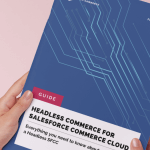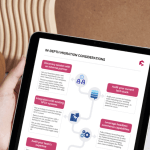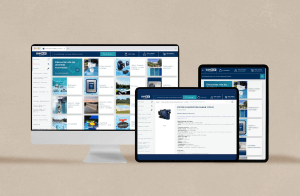Headless commerce is an e-commerce architecture where the frontend is decoupled from the backend. This separation allows businesses to be more agile, flexible, and innovative in how they deliver digital experiences to customers across multiple channels.
Traditional monolithic e-commerce platforms like Salesforce Commerce Cloud (SFCC) can struggle to keep up with the pace of change in customer expectations and technology. The tightly coupled frontend and backend make it difficult and time-consuming to update the customer experience or add new features. Not to mention the hidden costs of a monolithic storefront that accrue over time.
Improve your SFCC Experience with Headless Commerce in under 16 weeks by migrating to a headless frontend, and keeping your Commerce Cloud backend intact. Continue reading to learn more about the benefits of headless commerce, reaching your objectives with a headless frontend, migration and real world examples.
The key benefits of a headless approach for Salesforce Commerce Cloud
There are many advantages got a headless architecture in e-commerce. Below are some of the main benefits:
- Faster time-to-market for new features and experiences, as changes to the frontend no longer require extensive backend development.
- Improved flexibility to customize the customer experience and experiment with new designs and functionality without impacting core commerce operations.
- Omnichannel capabilities, allowing a consistent brand experience across web, mobile, and other touchpoints.
- Greater scalability and performance by decoupling the frontend from the backend infrastructure.
Dive deeper into the benefits of headless commerce for Salesforce Commerce Cloud here.
Migration to a Headless Salesforce Commerce Cloud
Transitioning to headless commerce with Salesforce Commerce Cloud is not just a technological upgrade; it’s a strategic move to future-proof your e-commerce operations and stay ahead. By strategically planning your migration journey and leveraging best practices, you can position your business for sustained growth. Let’s get started:

Headless Commerce for Salesforce Commerce Cloud: The Guide
Strategies
There are three different different migration approaches available for SFCC users transitioning to headless commerce: Big-Bang Replatforming, Progressive Approach, and Hybrid Approach.
Big-bang Replatforming involves completely replacing Salesforce Commerce Cloud with a new headless commerce solution. While it offers maximum flexibility, it also comes with higher risks and costs. This approach is best suited for businesses seeking a clean break from their legacy systems.
With a Progressive Migration, businesses transition incrementally, migrating specific functionalities or touchpoints to headless while keeping SFCC for the functions specifically needed. This minimizes disruption and spreads out migration costs over time.
The Hybrid Approach takes a similar stance to the progressive approach, maintaining SFCC for backend operations while developing and integrating a new headless front-end.
The choice ultimately depends on factors such as the complexity of the existing e-commerce platform, technical expertise, budget, timeline, and long-term business goals. We outline the pros and cons of the different migration strategies in more detail in our Guide to Headless Commerce implementation.
Best practices
A smooth migration to headless commerce will mean focussing on planning, collaboration, and ongoing optimization:
- Planning: This involves a strong understanding of headless architecture, a clear definition of migration goals, and careful consideration of the chosen migration approach (big-bang, progressive, or hybrid)
- Collaboration: Successful migration requires close collaboration between business stakeholders, IT teams, and any external partners involved in the process.
- Ongoing Optimization: Even after a successful migration, ongoing monitoring and optimization are crucial. This ensures the headless architecture continues to meet your evolving business needs and delivers the expected performance improvements.
Get guidance on best practices to ensure a successful and seamless transition to a headless architecture, such as stakeholder alignment and change management. Minimize risks and ensure a successful transition to a headless commerce architecture with Salesforce Commerce Cloud.
Key tools and resources for SFCC migration to headless
Various tools and resources can facilitate the migration from SFCC to a headless commerce architecture, including:
- Development tools
- Data management solutions
- API integration platforms
- Project management software
Leveraging the right tools and resources is crucial for a successful migration, as it helps with technical implementation, data handling, and overall project coordination.
To get started, read this comprehensive guide for Salesforce Commerce Cloud users looking to unlock the benefits of headless commerce and plan their migration journey.
We’ve also created a downloadable guide and checklist for implementing a headless architecture with your current Salesforce Commerce Cloud Platform. Start planning your transition to headless commerce today!

Everything you need to plan migration to Headless Commerce for Salesforce Commerce Cloud
A Headless Storefront for Salesforce Commerce Cloud Users
Front-Commerce is a headless frontend solution for e-commerce that empowers Salesforce Commerce Cloud (SFCC) users to leverage the benefits of headless commerce.
Front-Commerce decouples the front-end presentation layer from the back-end commerce functionality of SFCC. This allows SFCC users to build highly customized, content-rich, and innovative front-end experiences without being constrained by SFCC’s built-in front-end tools. By decoupling the presentation layer from the commerce engine, Front-Commerce enables SFCC users to deliver exceptional, customized, and agile customer experiences, ultimately unlocking the full potential of headless commerce with their existing e-commerce functionality.
By separating the front-end and back-end, Front-Commerce enables SFCC users to:
- Achieve true omnichannel experiences across various digital touchpoints and channels, as the front-end can be tailored independently.
- Fully customize the front-end user experience and interface to match brand and customer preferences, without impacting the back-end commerce functionality.
- Rapidly develop and deploy new front-end features and experiences to quickly adapt to changing customer needs and market trends.
- Improve front-end performance, flexibility, and scalability by leveraging modern front-end technologies and frameworks and e-commerce APIs.
- Integrate best-of-breed third-party tools and services into the front-end without affecting the back-end SFCC platform.
- Implement high performance mobile shopping experiences with a mobile-first headless frontend.
Initial investment concerns
Headless migration requires an initial investment, however the long-term benefits that outweigh the upfront costs:
- Reduced Long-Term Costs: Headless architecture offers greater flexibility and scalability, potentially reducing the need for costly customizations or platform upgrades in the future.
- Improved ROI: The improved speed, performance, and user experience of headless storefronts can lead to higher conversion rates and increased sales.
- Future-Proof Technology: Headless commerce allows you to adapt to evolving technologies and customer expectations without being constrained by a monolithic platform.

Development Complexity: Empower Your Development Team
Headless commerce can help streamline development tasks. By decoupling the front-end from the back-end, development teams gain:
- Focus and Efficiency: Developers can specialize in their areas of expertise (front-end vs back-end) leading to faster development cycles.
- Freedom of Choice: Teams can leverage a wider range of tools and technologies best suited for the front-end experience.
- Improved Code Maintainability: A cleaner separation of concerns can simplify code maintenance and updates in the long run.
Real Headless Commerce Case Studies
Headless commerce is not just about buzzwords, but can deliver tangible results in terms of improved website performance, customer engagement, and sales growth. When implemented with solutions like Front-Commerce, it can deliver real performance improvements, increased sales, and a more unified customer experience for businesses.
Discover concrete examples of businesses that have achieved measurable benefits from adopting a headless commerce approach, including: Devialet, Paula’s Choice and Bonne gueule.

The Future of E-Commerce is Headless
Transitioning from Salesforce Commerce Cloud to a headless commerce architecture is a strategic move to future-proof your e-commerce operations and unlock growth opportunities. By implementing headless commerce, SFCC users can enjoy faster time-to-market for new features, improved flexibility to customize the customer experience, omnichannel capabilities, and greater scalability and performance.
There are several ways to migrate to a new platform. Each has its own pros and cons. It’s also important to have the right tools and resources. Whether you’re planning a migration or exploring headless commerce, Front-Commerce can help.
Explore our guide to headless commerce for Commerce Cloud and consider contacting our team for assistance. With the right strategy and support, you can navigate headless commerce with confidence, positioning your e-commerce for growth and success.
